Maslenitsa is considered one of the oldest holidays, because it existed in Russia even in pagan times. It was from that time that some rituals were preserved, such as baking pancakes, burning stuffed people in carnival and jumping over the fire.
Despite the fact that some of the rituals have a pagan connotation, the traditions of the modern celebration are closely intertwined with religious canons. Why and when do they burn the carnival, and what is the meaning of this ritual?
The origins of the tradition
Burning stuffed carnival - the rite is very important, semantic, directly related to fertility. Many centuries ago they believed that through sacrifice one can get rid of any troubles and adversities. That is why the very stuffed man was made in the image and likeness of man. In addition, carnival loved to dress in a variety of women's dresses, associating it with the passing winter.
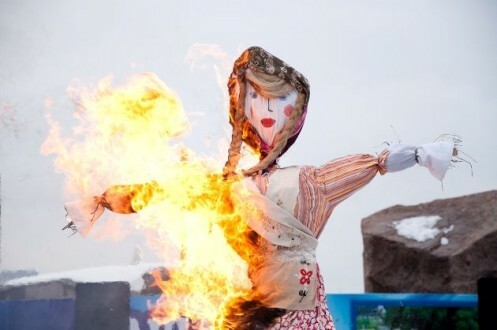
For what specific reasons did the burning of stuffed animals take place in antiquity?
- People believed that along with the death of the Maslenitsa scarecrow all the sorrows and hardships go away from life.
- Also similar ceremony was the symbol of winter wires.
- The burning of a scarecrow had another important purpose: improving the fertility of the earth, because through the ritual death of the Maslenitsa scarecrow, fertile lands returned to life.
Burning stuffed carnival was indeed a ritual important and semantic, but only in antiquity. Now they treat him with respect, but no more. People no longer believe in the need for ritual sacrifice in order to increase future harvests, turning the carnival burning into fun entertainment, directly signifying the beginning of Lent.
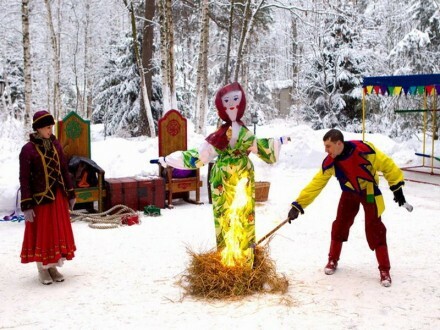
For the first time this tradition is mentioned in the first written sources concerning the ancient Russian state. Then the holiday lasted not 7, but as much as 14 days, and sometimes during this time there were several ritual arson attacks of a straw dummy. For the ancient Slavs, it was important not only to betray the image of the carnival to fire, but also to perform a ritual burial of ash. It was believed that the ash should be buried in the ground, as this increased the yield of fields and meant the final arrival of spring. Now such burial of ashes practically does not occur anywhere.
Features of creating Maslenichnogo stuffed
One of the most popular issues arising on the eve of the holiday - about why they burn stuffed carnival. The peculiarities of the religious and pagan implication of such burning have already been described above, it remains to find out what nuances existed for the creation of the scarecrow itself. This symbol of celebration was always created according to the following rules:
- a scarecrow was performed by
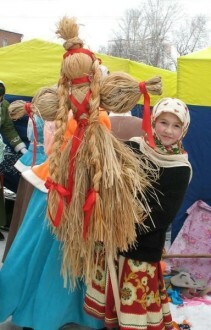 either from straw or from old rags, as these materials burned perfectly;
either from straw or from old rags, as these materials burned perfectly; - this object was traditionally given the features of a female body;
- also carnival almost always dressed in women's clothing;
- a scarecrow was traditionally planted on a stake or on another large, long stick, so that it would be convenient to observe all the inhabitants of the city for its burning.
Almost always the symbol of the celebration was created on Monday, the first day of the carnival celebration. Then it was just beginning to be made from straw, incidentally dressing in women's clothes. Similar figures were made almost in every house, but the square was traditionally burned only the most beautiful and large. The production ended either by the evening of Monday, or by the morning of Tuesday. Then people loaded a scarecrow on a sled and went with him to travel around the village.
The ritual carnival of the carnival lasted throughout the festive week until Sunday. The burning of the scarecrow took place not only in the central squares, but also in the courtyards of many houses.
Some peoples decided not to burn a ritual effigy, but to drown it in an ice-hole. However, this version of the course of the ritual quite quickly fell into oblivion due to its non-entertainment.
When creating this figure, almost always used unnecessary things that a person would like to get rid of. Burning them with a scarecrow, each family not only hoped for an excellent harvest, but also cleared its own space, destroying everything that was unnecessary and interfering with family well-being.
Detailed scenario of the burning of
The story of a scarecrow on Shrovetide dates back to pagan times when this ritual had a clear religious implication. Then the huge figure was burned early in the morning on Sunday.
- A gigantic scarecrow was set on a sleigh, and next to it a beautiful girl was dressed, dressed in much the same way as a carnival.
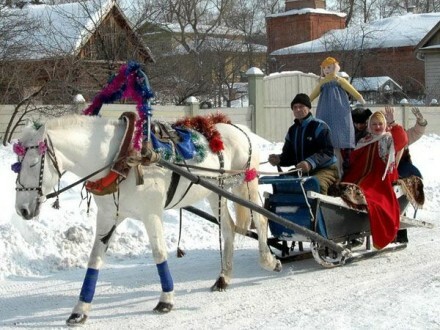
- A wagon with a straw figure and a girl moved to the central square of the village, and behind it a real procession was built. People rode a column on horseback or followed a scarecrow, singing carols and dancing.
- Once the scarecrow was on the burning site, it was installed, and people were allowed to have fun around. Do not forget that the holiday had a religious connotation, which means that the villagers had to completely repeat the rite inherited from their ancestors. Songs and dances here symbolized religious immersion in trance.
- After a couple of hours, the figure was set on fire. The torch to the straw scarecrow was usually brought up by the head of the settlement, because this mission was honorable and important.
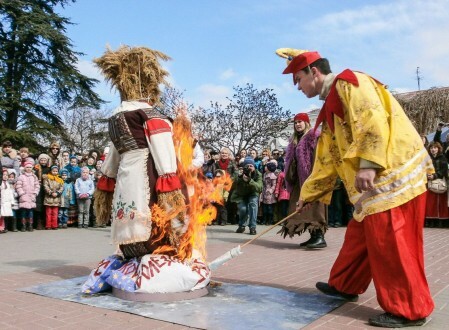 All the rest of the people continued to sing and dance, and at the same time throwing the rest after the carnival meal into the fire. It was believed that pancakes and tortillas, left after the carnival, should be destroyed, because ahead of people waiting for a long post. Such food was usually burned, but sometimes given to the poor and the poor.
All the rest of the people continued to sing and dance, and at the same time throwing the rest after the carnival meal into the fire. It was believed that pancakes and tortillas, left after the carnival, should be destroyed, because ahead of people waiting for a long post. Such food was usually burned, but sometimes given to the poor and the poor. - The celebration took place until the main symbol of the celebration burned out completely. After that, the villagers had only to collect the ashes and burn it. Leaving the ash after the religious procedure was a bad sign, because it was believed that then the harvest would be bad, and sudden colds could destroy the crops. Buried such ash in the fields, where a large crop was grown. Together with the ashes, they could also bury the remains of food and tiny figures from straw.
In some provinces, there was a tradition of burning small straw figures. Such figures were made in several copies, and each of them meant something that a person wants to say goodbye. So, for example, when burning small stuffed animals, a person could wish to get rid of the disease or from unhappiness in love.
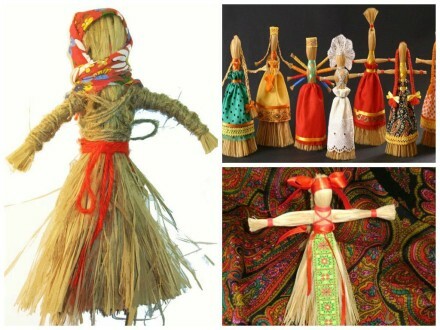
Interesting rituals related to the Maslenic Scarecrow
As the holiday was amazingly popular, its script at times markedly changed. So, for example, in some provinces the effigy was not burnt, and the symbol of celebration was people dressed up in the manner of straw figures. Usually a beautiful girl made a symbol of celebration, but could dress up an old woman or a local respected person.
The rite of burning the most scarecrow was also modified. They threw everything into the fire, starting from small figures and ending with wooden logs. What could go into such a fireplace with a piece of straw?
- In some provinces, religious wheel burning was carried out from a tree, which was a symbol of the sun.
- Also people could throw in a fire of a piece of paper with wishes and requests.
- Old things, such as bast shoes or shirts, were often burned to religious destruction, and with their help people tried to get rid of misfortunes.
In Kostroma 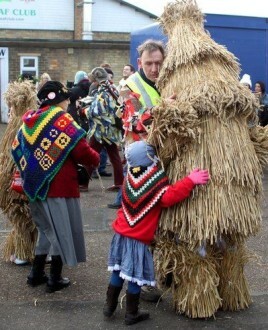 province there was a tradition of burning "a straw man".Each inhabitant of the village took a small bundle of straw and threw in a common heap, under the feet of a figure of straw. When enough of the flammable material was gathered at the feet of the peasant, it was set on fire, thus symbolizing the cold and frost. Also in Kostroma province many men went to travel on wagons through the city in special straw caps. In the evening, these caps were burned, as a symbol of the onset of spring and farewell to the winter.
province there was a tradition of burning "a straw man".Each inhabitant of the village took a small bundle of straw and threw in a common heap, under the feet of a figure of straw. When enough of the flammable material was gathered at the feet of the peasant, it was set on fire, thus symbolizing the cold and frost. Also in Kostroma province many men went to travel on wagons through the city in special straw caps. In the evening, these caps were burned, as a symbol of the onset of spring and farewell to the winter.
Immediately after burning such stuffed people went home or to church. With the last glimpses of the bonfire, the feast was coming to an end, which meant the time of Lent. It was believed that the ritual burning purified the soul of each person, and now people could live in anticipation of something bright and memorable.
The modern meaning of the
tradition Why burn carnival now is a completely different matter, because modern ritual has absolutely no religious connotation. For a whole week, people consume plenty of pancakes, and burning a straw effigy becomes entertainment rather than a ritual with a special meaning.
- The Scarecrow itself is not manufactured on the first day of festivities in every home, but is made to order by Sunday.
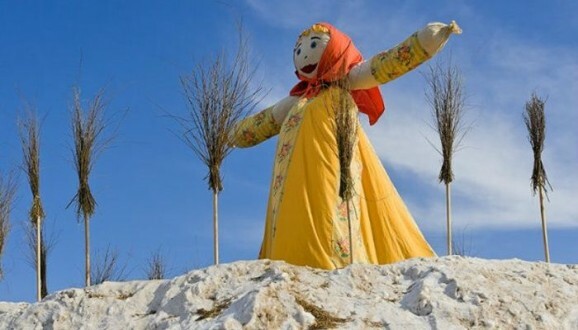
- Ritual burning takes place only in the main squares and in the places where special events were organized.
- The ash left after the straw scarecrow does not flutter through the fields and is not buried in the ground.
- The tradition of burning old clothes or the remains of a festive meal has also disappeared.
The traditions of the carnival celebration were constantly changing and transformed because the ministers of the church advocated the cancellation of the celebration. Both Catherine II and Peter I fought for the cancellation of the holiday, but for the common people Shrovetide has long become not a symbol of pagan traditions, but an important part of future religious festivities.
Now burning stuffed carnival - this is not such an important rite, but it continues to be carried out everywhere on Sunday this festive week. For ordinary people, this ritual became a symbol of the end of celebrations and the approach of the great post, and without it it is difficult to imagine Shrovetide.
Related Videos:
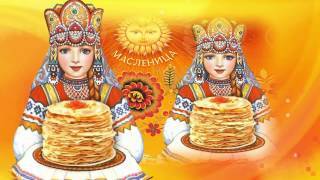 7:41
7:41  16:11
16:11 